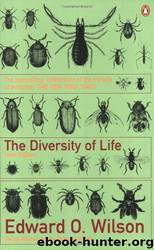The Diversity of Life by Edward O. Wilson

Author:Edward O. Wilson
Language: eng
Format: epub, mobi
ISBN: 9780141931739
Publisher: Penguin Books Ltd
Published: 2009-03-08T16:00:00+00:00
The extinct New Zealand mistletoe (Trilepidea adamsii).
clade surviving to a greater and greater age falls off as an exponential decay function. If, to use an oversimplified example, one half the species are alive at the end of a million years, about one half of those (or one quarter of the original) persist 2 million years, one half of those again (or one eighth of the original) last 3 million years, and so on. The progression is often accelerated by shifts in climate that cause waves of extinction and subsequent rebirth—not only the great catastrophes that ended the Paleozoic and Mesozoic eras but smaller, more frequent, and more local events. Clades of buffalos and antelopes in Africa south of the Sahara have persisted from 100,000 to several million years. But about 2.5 million years ago many came to an end, and others first appeared almost simultaneously. The controlling event was apparently a period of cooling and diminished rainfall that caused grasslands to spread over a large part of the African continent.
Local climatic instability is only one of the reasons not to generalize too quickly about the lifespan of species from the fossil record. Sibling species, so similar in anatomical detail as not to be traceable in fossils, could come and go in rapid succession without being detected. Small local species might also turn over at a high rate in places where fossilization seldom occurs, such as desert valleys and the interiors of small islands, leaving no evidence whatever of their existence.
We know that contemporary species formation in the northern Andean cloud forests is both profuse and resistant to the formation of fossils. In the mountain habitats of Colombia, Ecuador, and Peru, populations of plants and animals are prone to fast evolution and early extinction by geographical location alone. The ridges on which they live are isolated and differ from one another in temperature, rainfall, and the species composing local communities. The populations are small. Alwyn Gentry and Calaway Dodson estimate that in these places some orchid species could multiply in only fifteen years. By implication, the longevity of species might be short as well, measured in decades or centuries. Orchids are by far the most diverse of living plants, comprising at least 17,000 species or 8 percent of all flowering plants. Many are rare and local like the Andean endemics, and they could originate and die at a high rate without leaving a trace. The general biology of orchids is also such as to erase their history. They live mostly in the tropics, where the fossil record is poor. Most grow as epiphytes in the crowns of forest trees, a habitat not conducive to the fossilization of plant parts. And unlike the vast majority of other flowering plants, they do not scatter their pollen as simple grains, letting much of it fall into lakes and streams where it can form easily studied microfossils. Instead, orchid plants bind pollen together in solid bodies, the pollinia, which are carried from flower to flower by insects.
Download
This site does not store any files on its server. We only index and link to content provided by other sites. Please contact the content providers to delete copyright contents if any and email us, we'll remove relevant links or contents immediately.
Man-made Catastrophes and Risk Information Concealment by Dmitry Chernov & Didier Sornette(5956)
The Revenge of Geography: What the Map Tells Us About Coming Conflicts and the Battle Against Fate by Kaplan Robert D(4052)
Zero Waste Home by Bea Johnson(3805)
COSMOS by Carl Sagan(3589)
Good by S. Walden(3521)
In a Sunburned Country by Bill Bryson(3508)
The Fate of Rome: Climate, Disease, and the End of an Empire (The Princeton History of the Ancient World) by Kyle Harper(3033)
A Wilder Time by William E. Glassley(2835)
Camino Island by John Grisham(2778)
Organic Mushroom Farming and Mycoremediation by Tradd Cotter(2661)
The Ogre by Doug Scott(2657)
Human Dynamics Research in Smart and Connected Communities by Shih-Lung Shaw & Daniel Sui(2479)
Energy Myths and Realities by Vaclav Smil(2463)
The Traveler's Gift by Andy Andrews(2436)
9781803241661-PYTHON FOR ARCGIS PRO by Unknown(2343)
Inside the Middle East by Avi Melamed(2328)
Birds of New Guinea by Pratt Thane K.; Beehler Bruce M.; Anderton John C(2237)
A History of Warfare by John Keegan(2214)
And the Band Played On by Randy Shilts(2166)
